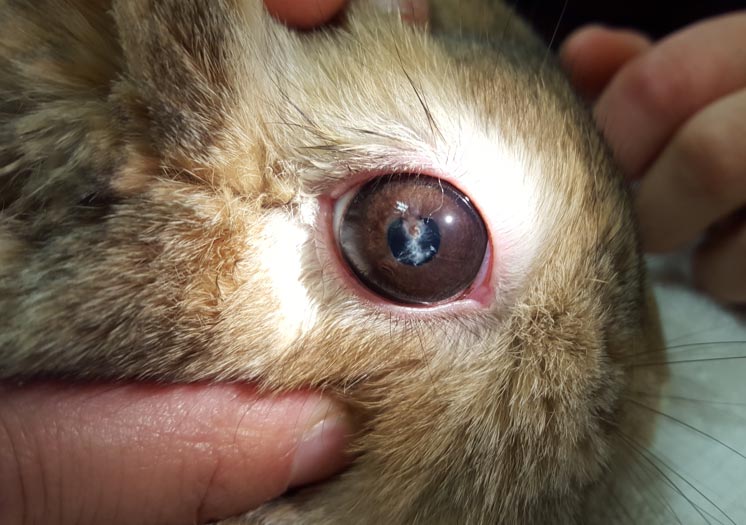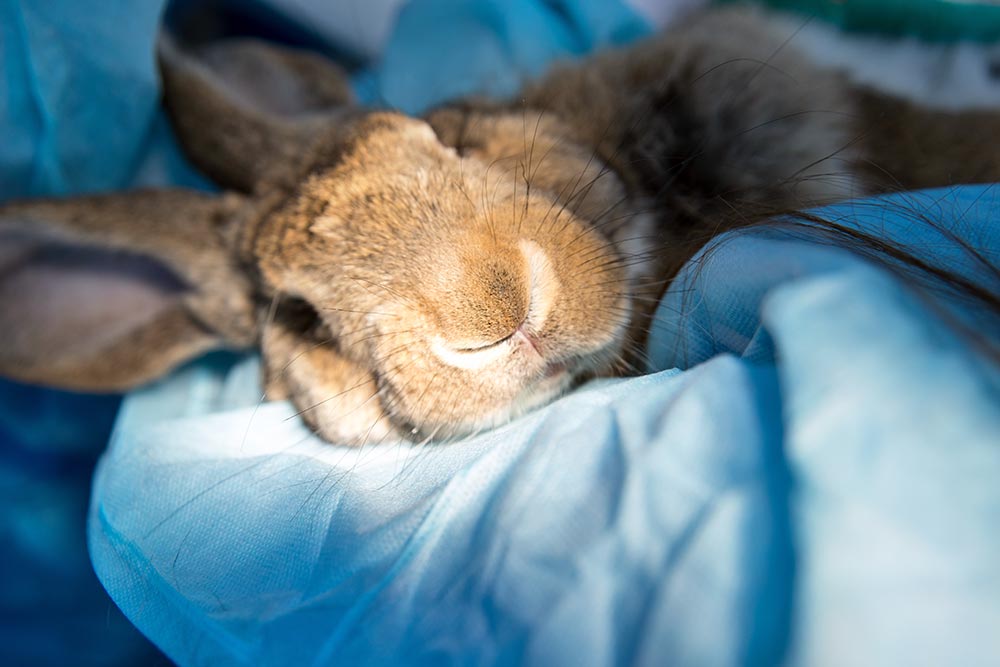22 Feb 2021
Rabbits: now and in the future
Despite huge strides in knowledge in the past two decades, many aspects of rabbit medicine and surgery are yet to be fully understood. With this in mind, Rabbit Welfare Association and Fund veterinary advisor Richard Saunders outlines some of the “leaps and bounds” he’d like to see in the near future for the UK’s third most popular pet.

Image © alexkmedia / Adobe Stock

Rabbit medicine has come on leaps and bounds over the past 20 years, with the publication of the first BSAVA manual for rabbits in 2000 and Frances Harcourt-Brown’s Textbook of Rabbit Medicine in 2002.
Both textbooks have been updated considerably over that time, as new developments in rabbit medicine emerged, and will doubtless continue to do so. We can expect to see updating of these texts, further research articles, and a commensurate increase in rabbit teaching at undergraduate and postgraduate level as more becomes known.
We certainly don’t yet fully understand some areas of medicine and surgery, yet very much need to, to effectively diagnose and treat these patients. At present, many aspects of rabbit care are frustrated by this lack of knowledge and we often cannot even give owners an accurate prognosis for some conditions.
Encephalitozoon cuniculi
In particular, we do not appear to have made huge headway with the diagnosis and treatment of Encephalitozoon cuniculi recently, with no reliable single test to determine active disease from the parasite – and the tests that are available are limited in usefulness.
Serology only demonstrates exposure to infection, and while IgM rises within approximately a week and falls approximately within a month, IgG can remain high for more than a year, so it is unclear how relevant a positive result is and how recently infection was acquired, especially in the absence of clinical signs. And as signs may be quite vague and subtle, such as changes in hearing and mentation, this remains a challenging condition to definitively diagnose in every case.
PCR testing is limited in that shedding of the parasite in urine is intermittent. Protein electrophoresis hasn’t proved quite as specific to E cuniculi as hoped.
With these limitations, the uptake of testing is not as high as we would like, and previous serosurveys suggest 25% to 50% of rabbits have been exposed to infection, but the actual numbers of rabbits that develop clinical signs is very difficult to determine.
At least a treatment option exists, in fenbendazole, that is readily available and inexpensive. More definitive data to determine the optimum dose and duration of treatment would be welcomed, as current recommendations are based on a single paper (Suter et al, 2001) – and as anyone who has given 28 days daily medication to rabbits knows, it could be more palatable.

Diagnostics
Practice management software has the potential to be incredibly useful in determining the prevalence and incidence of such issues in the British rabbit population, but has been limited so far to clinical appearance of disease rather than definitive diagnosis – in part because of the limitations of testing and in part because of the costs associated with them.
Some exciting data has come out of this area so far, with more doubtless, to come (Turner et al, 2018; Farrell et al, 2020).
While it’s fair to say that owners’ funds may be limited, in my role as veterinary advisor for the Rabbit Welfare Association and Fund (RWAF), it is common that owners tell me they wish vets had suggested more diagnostics, rather than assuming they would not consent if offered.
Knowledge gaps
There are a few other areas of rabbit care where a distinct paucity of knowledge exists.
While the nutrition of the meat rabbit is well understood, diets for long-term health – particularly with respect to dental disease, including calcium:phosphate ratios and vitamin D levels – still need work. Related to this, are indoor rabbits really more at risk of dental disease due to lack of exposure to sufficient UV light, or is the indoor rabbit population simply better observed?
Disease prevention is a vital area for now and the future. Preventive health care for rabbits is still not adequate, with the 2018 PDSA Animal Welfare Report showing that approximately 50% of rabbits were neither vaccinated nor neutered. While that’s a massive improvement on the time when neutering female rabbits was a rarity and male rabbits would be castrated under “hypnosis” (tonic immobility is the induction of a quiescent state in rabbits, but with no stress alleviation and absolutely no analgesic effect), it’s still half as many as is necessary to avoid the approximately 60,000 that arrive at rescue centres every year (Todd, RWAF, unpublished data).
Likewise, as a profession, I feel we are a little reluctant to strongly advise vaccination. Again, it’s common for me to hear owners say vets have not mentioned vaccination of their rabbits, despite the fact we have a resident reservoir population of wild rabbits out there ensuring exposure to myxomatosis and rabbit viral haemorrhagic disease (RVHD) is common. As fatal, endemic diseases, these should be considered core vaccines for rabbit patients. And if the RVHD1 variant K5 hits the UK in the future, that will be another reason to ensure vaccination with the existing combination vaccine.
Other areas for future research include social behaviours, space requirements and limb mechanics – with particular reference to sore hocks and motility disorders – as we still don’t know what the “normal” and optimal conditions are.
I would like to see research into prevention and management of postoperative adhesions, as well as some poorly understood areas of rabbit gastrointestinal motility, such as the disturbed caecal motility we sometimes see causing abdominal distension or chronic soft faeces.
And I am fairly convinced we are yet to definitively diagnose at least a couple of specific skin conditions in rabbits – characterised in one syndrome by a very non-specific chronic inflammatory process, and in another by something that may turn out to be true atopy, but needs more work; I’m occasionally presented with the rabbit that “is allergic to grass”, which is unfortunate and ironic.

Anaesthesia and analgesia
Anaesthesia has improved enormously over the past few years due to advances in airway management, increased uptake of endotracheal intubation as routine, and development and licensing of new drugs. But much room for improvement still exists when morbidity and mortality rates are still significantly higher than in our canine and feline patients.
Likewise, analgesia often lags behind that used in dogs and cats. This may be for many reasons – lack of knowledge about doses; safety concerns; and most commonly, difficulty in assessing how much pain the rabbit patient is in, due to their prey nature, where they hide signs of vulnerability from potential predators.
These can be countered and improved by, respectively, greater access to – and use of – suitable references (Hedley, 2020; Carpenter and Marion, 2017) to determine suitable dose regimes; “myth busting” in texts and CPD (the relative risk of gastrointestinal motility reduction due to opioid analgesics is much lower than inhibition of motility due to pain, for example), and grimace scales and other pain scoring techniques continuing to increase in popularity for this species.
This, hopefully, goes hand in hand with the availability of new products and techniques. The use of relatively cheap and simple local analgesic blocks for elective surgery and dentistry, the increased use of full opioid agonists – such as methadone – where appropriate (with care to maintain effective analgesia after it has been metabolised, given its shorter action than buprenorphine), and considering newly emerging NSAIDs.
While meloxicam is an excellent NSAID (its liquid formulation being palatable and easy to accurately dose with), recent availability issues have flagged that overreliance on one product is unwise, and patients do vary in their response to NSAIDs, meaning alternatives may prove useful.
I’d like to see those leaps and bounds continue for the UK’s third most popular mammalian pet, and one that still needs to catch up with cats and dogs in how it is treated.
References
- Carpenter J and Marion C (2017). Exotic Animal Formulary (5th edn), Saunders, Philadelphia.
- Farrell S, Noble PJ-M, Pinchbeck GL, Brant B, Caravaggi A, Singleton DA and Radford AD (2020). Seasonality and risk factors for myxomatosis in pet rabbits in Great Britain, Preventive Veterinary Medicine 176: 104924.
- Hedley J (2020). BSAVA Small Animal Formulary Part B: Exotic Pets (10th edn), BSAVA, Gloucester.
- Suter C, Müller-Doblies UU, Deplazes P and Hatt JM (2001). Prevention and treatment of Encephalitozoon cuniculi infection in rabbits with fenbendazole, Veterinary Record 148(15): 478-480.
- Turner R, Arsevska E, Brant B, Singleton DA, Newman J, Noble PJ-M, Jones PH and Radford AD (2018). Risk factors for cutaneous myiasis (blowfly strike) in pet rabbits in Great Britain based on text-mining veterinary electronic health records, Preventive Veterinary Medicine 153: 77-83.
